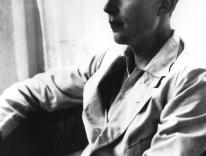At the risk of philistinism, I’m going to indulge in some casual fun about high fashion, some mirth at la mode.
Did you happen to catch last week’s roundup of the newest from the fashion runways of Paris? Browsing through what presumably represents the best of the world’s best designers, I found myself at a loss for words (well, for a few minutes at any rate), and rushed to show the newspaper to my wife – as if merely being a woman might equip her to decode the formidable hermeneutics of high fashion.
One way to comprehend and justify the lunacy of these outfits might come from science and literature, disciplines in which strange and unfettered actions on the outer boundaries of reality often do, in time, yield results back on earth. Many useful daily technologies trace their lineage to pure scientific research; and in literature, while nobody reads Gertrude Stein – or did even in her lifetime – her eccentrically minimalist prose yielded up a lode of mainstream fiction that ran from Hemingway to Raymond Carver and still informs American prose today. Might some similar trickle-down dynamic be at work with fashion, so that an echo of today’s bizarro breeches will be found in tomorrow’s business attire?
Or maybe it’s just that some cultural productions are meant to baffle -- not least because they then require a highly-trained corps of de-bafflers to interpret them for you. An old friend of mine, a trumpet player who went to Yale School of Music and viewed his education there as significantly overintellectualized, used to joked about the mantra one musicologist pummeled his students with: “Now, please do NOT confuse music with what you hear!” Much the same could be said about the strange contraptions worn by the stony-faced models who sashay down the runways of Paris. Please, do not confuse what they are wearing with clothes!
So then... what are they? Well, the Junya Wantanabe collection specializes in women who seem to be festooned with spare parts from a large HVAC project. (And some look pretty peeved about it.) One outfit from the house of Celine is essentially a bathrobe and pair of red galoshes. But my clear favorite of the showcased designers is Rei Kawakubo, of Comme des Garçons, who debuted her “blue witches” collection. One witch looks like she got entangled in a massive pile of blue velvet drapery in an Edwardian drawing room, then had vermillion foam sprayed all over her head. Another seems to be peeking out from behind a portable duck blind. A third has apparently been swallowed by a woolly mammoth. (You can take the whole New York Times tour here.)
One longs for a Tom Wolfe-like writer to do these outfits justice. Do you recall Wolfe’s satirical mischief-making in The Painted Word, his 1975 take-down of avant-garde art and the New York City art scene? As his title suggests, Wolfe’s chief thrust was that art had ceased being a visual experience directly available to the amateur viewer, and had become instead an illustration of art theory, to be mediated by critics; avant-garde artist and art critic engaged in an intimate pas de deux far over the head of the ordinary schmoe who, well, just wanted to look at beautiful paintings.
Wolfe’s rollicking rant took off from a review of contemporary realist paintings by vaunted art critic Hilton Kramer, who wrote in 1974 that while “realism does not lack its partisans, it does rather conspicuously lack a persuasive theory.” And, Kramer continued, “to lack a persuasive theory is to lack something crucial—the means by which our experience of individual works is joined to our understanding of the values they signify.”
Wolfe recounts that “Then and there I experienced a flash known as the Aha! phenomenon, and the buried life of contemporary art was revealed to me for the first time. The fogs lifted! The clouds passed! The motes, scales, conjunctival bloodshots, and Murine agonies fell away!... I had gotten it backward all along. Not ‘seeing is believing,’ you ninny, but ‘believing is seeing,’ for Modern Art has become completely literary: the paintings and other works exist only to illustrate the text.” And this, Wolfe boisterously argued, was the world of art turned upside-down.
Like all populist diatribes, Wolfe’s engaged in a number of convenient reductions and straw-man moves; but he was hilarious in the process, and his high-spirited lament at the elevation of theory and criticism over direct aesthetic engagement hit a nerve among art enthusiasts vexed by obscurantism and perplexed at having to rely on theorists to explain to them what they were looking at.
So – returning to Paris and those creations on the runway -- how does the Times explain the duck blind or the woolly mammoth? In attempting to make the show intelligible to us, fashion columnist Vanessa Friedman describes one designer’s success in “layering and contrasting sartorial stereotypes.” Assessing the “blue witches” collection, she praises Rei Kawabuko for refusing to “engage in unnecessary iterating,” adding that while “she does not feel the need to explain... the extravagance of the fabrics, their abundance and abstract historicism, conveyed an uncompromising generosity, barely contained by the tiny space around them and imbued with the poignancy of the disappearing women inside.”
Woolly mammoth, woolly prose. Friedman sums up her take on the show by noting, pithily, that “Discordant juxtapositions are part of the human condition. They just get a little more exaggerated when Fashion Week comes into play.”
As Wolfe would say, Too true, Vanessa, too true!
PS/ I will also note, on a far more serious note, the disturbing aesthetic of eating disorder that afflicts many of the models in this show. I have never understood how this grotesque aesthetic came to pass. Feminist-based critiques of media have put forth the concept of “the male gaze” to explain the propagation of idealized or objectified images of women based on the fantasies of men, and the tragic attempts of women to conform to them. I get the idea... but which male gazing at a woman wants to see an emaciated ruin? Any male I know would flinch and quickly turn away in horror. Talk about the poignancy of the disappearing woman.


